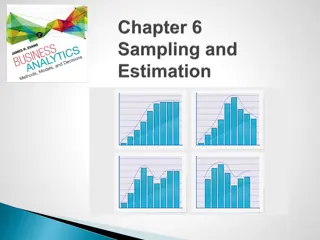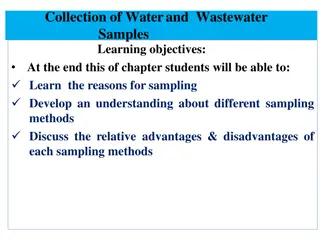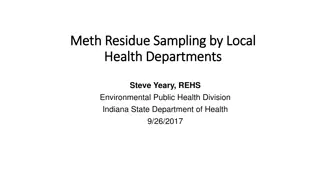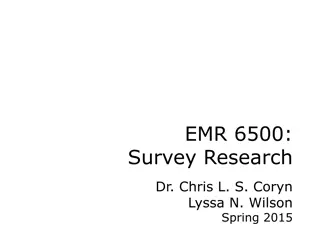Understanding Sampling: Definition, Advantages, and Disadvantages
Sampling is a crucial method in research, involving selecting a subset of a population for study. Learn about population, census, sampling frame, and more. Explore the advantages like cost-effectiveness and speed, along with drawbacks such as biasedness and need for specialized knowledge. Understand the importance of selecting a representative sample and the differences between a sample and a population.
Download Presentation

Please find below an Image/Link to download the presentation.
The content on the website is provided AS IS for your information and personal use only. It may not be sold, licensed, or shared on other websites without obtaining consent from the author. Download presentation by click this link. If you encounter any issues during the download, it is possible that the publisher has removed the file from their server.
E N D
Presentation Transcript
Introduction In the language of sampling: -a population is the entire collection of people or things you are interested in; -a census is a measurement of all the units in the population; -a sampling frame is the specific data from which the sample is drawn, e.g., a telephone book;
Contd. -a unit of analysis is the type of object of interest, e.g., fire departments, firefighters; -a sample is a subset of some of the units in the population; -a statistic is a number that results from measuring all the units in the sample;
Need of Sampling Large population can be conveniently covered. Time, money and energy is saved. Helpful when units of area are homogenous. Used when the data is unlimited.
Advantages of Sampling Economical: Reduce the cost compare to entire population. 2. Increased speed: Collection of data, analysis and Interpretation of data etc take less time than the population. 3. Accuracy: Due to limited area of coverage, completeness and accuracy is possible. 4. Rapport: Better rapport is established with the respondents, which helps in validity and reliability of the results 1.
Disadvantages of Sampling Biasedness: Chances of biased selection leading to incorrect conclusion Selection of true representative sample: Sometimes it is difficult to select the right representative sample Need for specialized knowledge: The researcher needs knowledge, training and technique, statistical analysis and calculation of probable error. Impossibility of sampling: Sometimes population is too small or too heterogeneous to select a representative sample. 1. 2. 3. experience in sampling 4.
Sample vs. Population Sample Population
What is a sample? A sample is a finite (fixed) part of a statistical population whose properties are studied to gain information about the whole(Webster, 1985). When dealing with people, it can be defined as a set of respondents(people) selected from a larger population for the purpose of a survey.
What is sampling? Sampling is the act, process, or technique of selecting a suitable sample, or a representative part of a population for the purpose of determining parameters or characteristics of the whole population.
Types of Sampling 1. probability sampling : A probability sampling scheme is one in which every unit in the population has a chance (greater than zero) of being selected in the sample, and this probability can be accurately determined. When every element in the population does have the same probability of selection, this is known as an 'equal probability of selection' (EPS) design. Such designs are also referred to as 'self-weighting' because all sampled units are given the same weight.
Probability sampling Probability sampling includes: Simple Random Sampling, Systematic Sampling, Stratified Random Sampling, Cluster Sampling.
Simple Random Sample Every subset of a specified size n from the population has an equal chance of being selected
Contd. Applicable when population is small, homogeneous & readily available All subsets of the frame are given an equal probability. Each element of the frame thus has an equal probability of selection. It provides for greatest number of possible samples. This is done by assigning a number to each unit in the sampling frame. A table of random number or lottery system is used to determine which units are to be selected.
Systematic Random Sampling Each unit in the population is identified, and each unit has an equal chance of being in the sample. Systematic sampling relies on arranging the target population according to some ordering scheme and then selecting elements at regular intervals through that ordered list. For example, to select a sample of 25 hostel rooms in your hostel, make a list of all the room numbers in the hostel. Say there are 100 rooms. Divide the total number of rooms (100) by the number of rooms you want in the sample (25). The answer is 4. This means that you are going to select every fourth room from the list. But you must first consult a table of random numbers. Pick any point on the table, and read across or down until you come to a number between 1 and 4.
Contd. This is your random starting point. Say your random starting point is "3". This means you select room 3 as your first room, and then every fourth room down the list (3, 7, 11, 15, 19, etc.) until you have 25 rooms selected. This method is useful for selecting large samples, say 100 or more.
Stratified random sampling Where population embraces a number of different categories, the frame can be organized into separate "strata." Each stratum is then sampled as an independent sub-population, out of which individual elements can be randomly selected. The population is divided into two or more groups called strata, according to some criterion, such as geographic location, grade level, age, or income, and subsamples are randomly selected from each strata.
Contd. For example, if you wanted to find out the attitudes of students on your campus about peace/education, you may want to be sure to sample students who are from every region of the country as well as foreign students. Say your student body of 10,000 students is made up of 8,000 - KP; 1,000 - Punjab; 500 - Sindh; 300 - Balochistan; 200 - Foreign.
Contd. If you select a simple random sample of 500 students, you might not get any from the KP, Sindh, or Foreign. To make sure that you get some students from each group, you can divide the students into these five groups, and then select the same percentage of students from each group using a simple random sampling method. This is proportional stratified random sampling.
Cluster sampling Cluster sampling is used in large geographic samples where no list is available of all the units in the population but the population boundaries can be well-defined. For example, to obtain information about the drug habits of all high school students in a province, you could obtain a list of all the school districts in the province and select a simple random sample of school districts. Then, within in each selected school district, list all the high schools and select a simple random sample of high schools. Within each selected high school, list all high school classes, and select a simple random sample of classes. Then use the high school students in those classes as your sample.
Non-Probability Sampling Non-probability sampling is a sampling technique where the samples are gathered in a process that does not give all the individuals in the population equal chances of being selected. Non-probability sampling includes: Convenience Snowball Purposive Quota
Contd. Most researchers are bounded by time, money and workforce and because of these limitations, it is almost impossible to randomly sample the entire population and it is often necessary to employ another sampling technique, the non-probability sampling technique.
Convenience Sampling Convenience/Accidental sampling is probably the most common of all sampling techniques. With convenience sampling, the samples are selected because they are accessible to the researcher. Subjects are chosen simply because they are easy to recruit. This technique is considered easiest, cheapest and least time consuming.
Snowball Sampling Snowball sampling is usually done when there is a very small population size. In this type of sampling, the researcher asks the initial subject to identify another potential subject who also meets the criteria of the research. The downside of using a snowball sample is that it is hardly representative of the population.
Purposive sampling Purposive as judgmental, selective or subjective sampling, reflects a group of sampling techniques that rely on the judgment of the researcher when it comes to selecting the units (e.g., people, cases/ organizations, events, pieces of data) that are to be studied. sampling, also known
Contd. Selecting participants because they have certain characteristics, no randomization. For example, you want to be sure include African Americans, Euro Americans, Latinos and Asian Americans in relatively equal numbers. predetermined
Quota Sampling Selecting participant in numbers proportionate to their numbers in the larger population, no randomization. For example you include exactly 50 males and 50 females in a sample of 100.






























